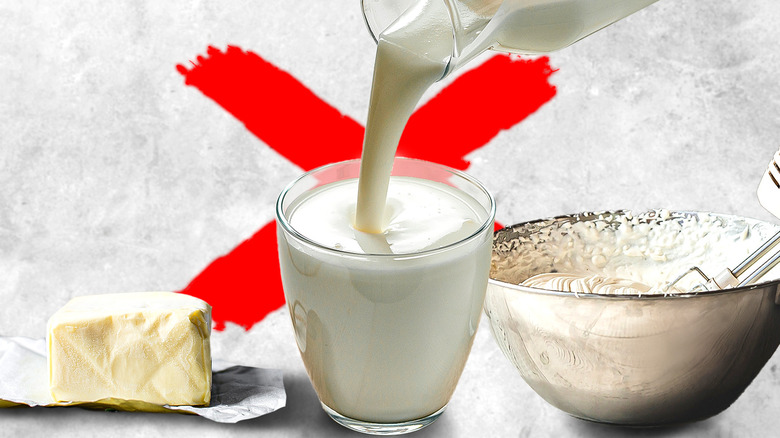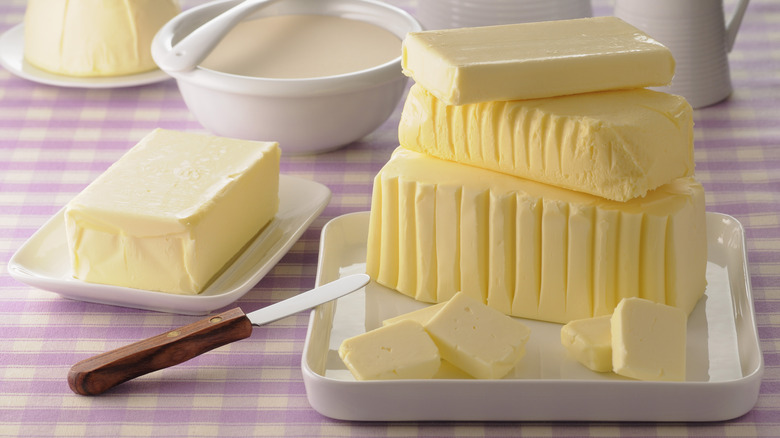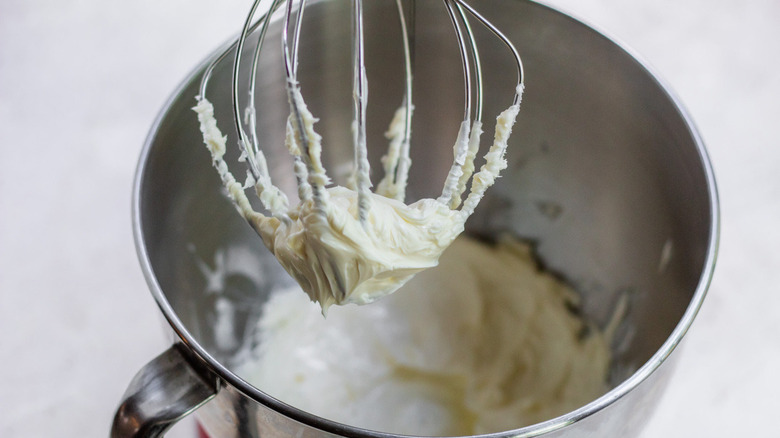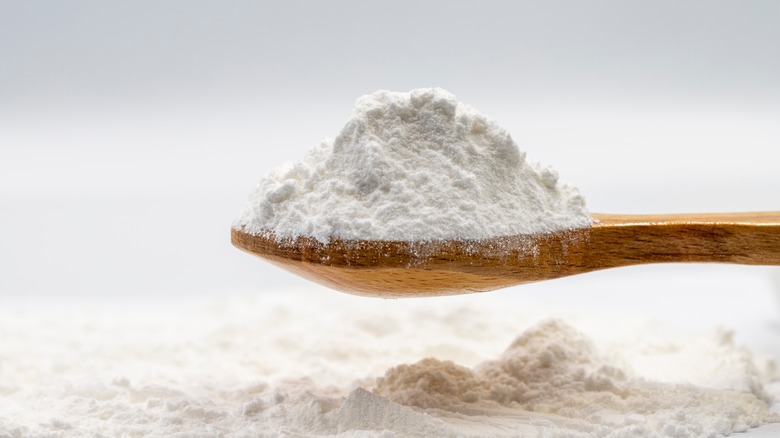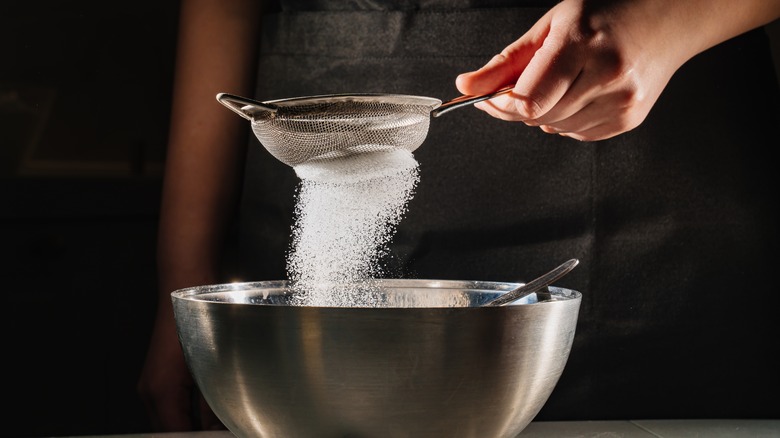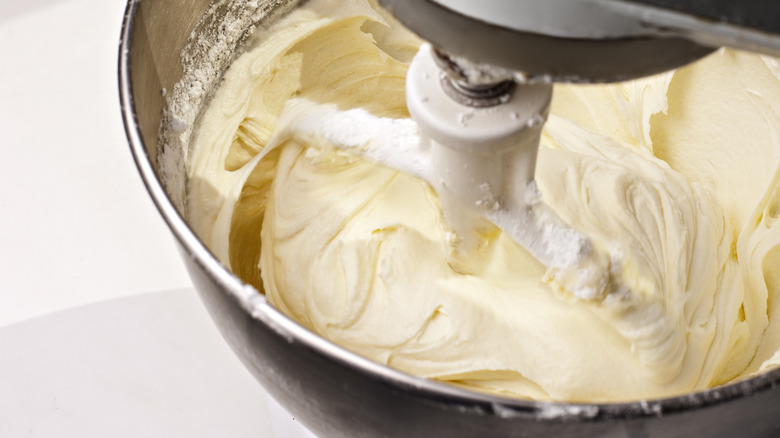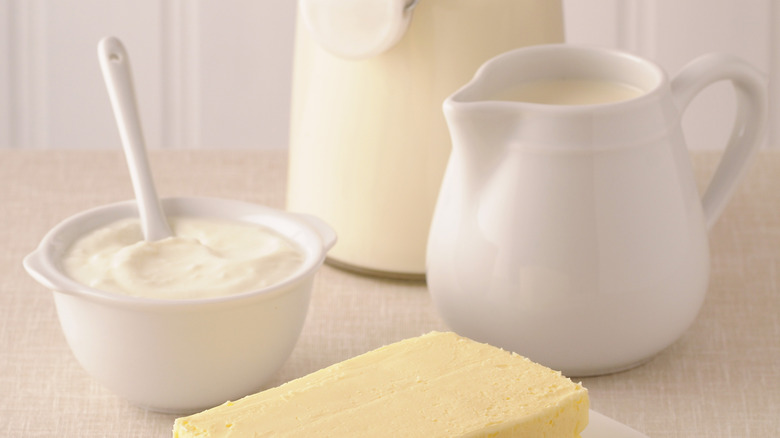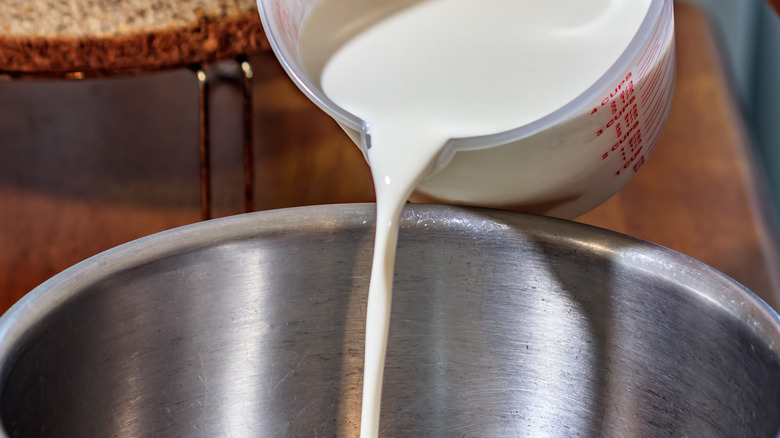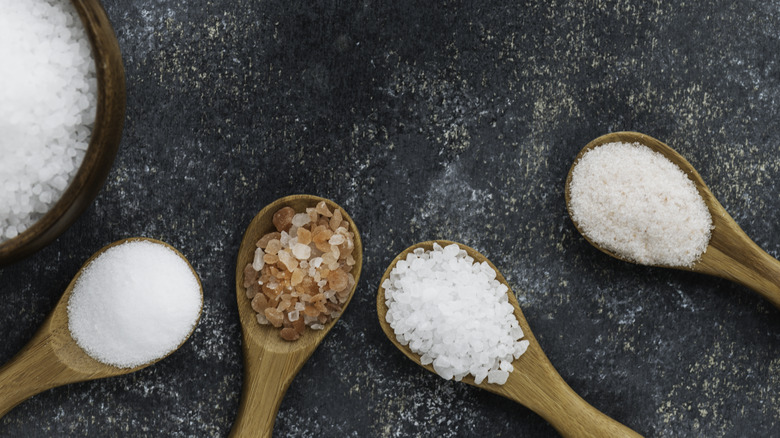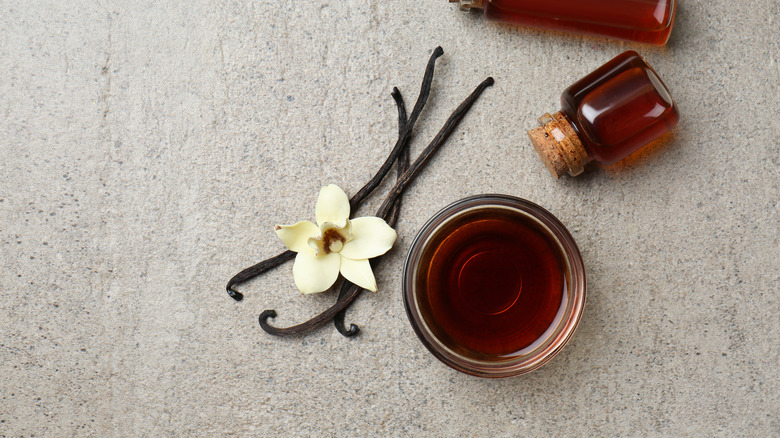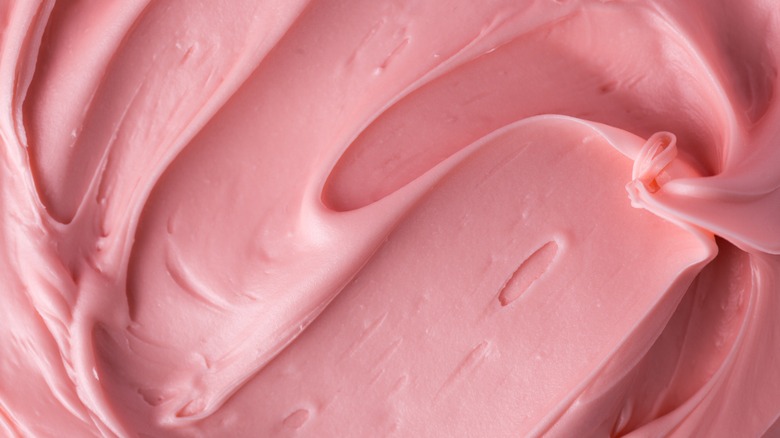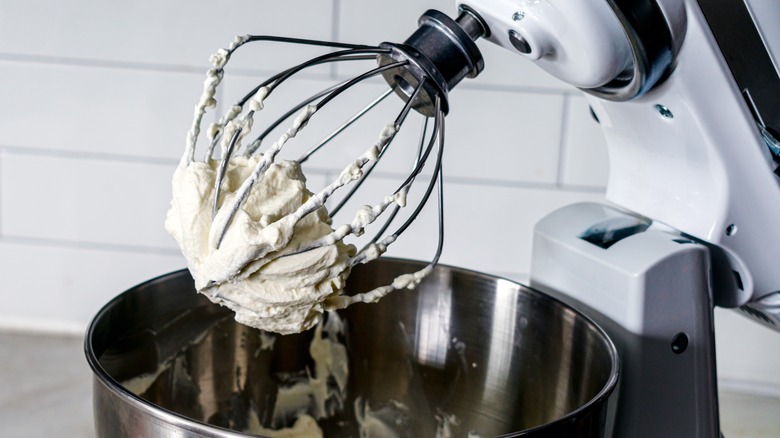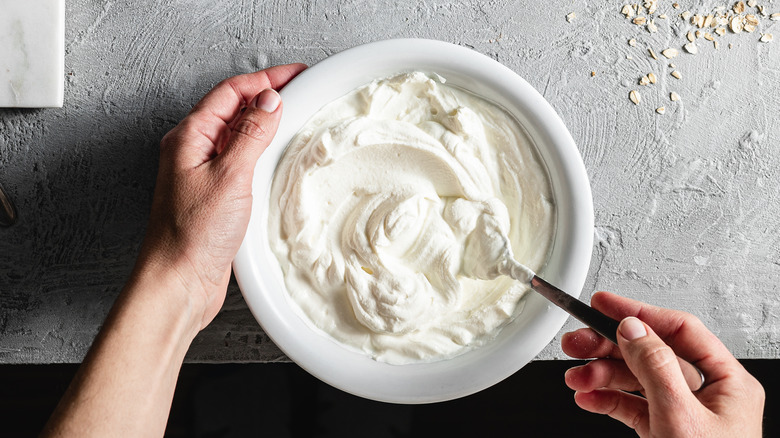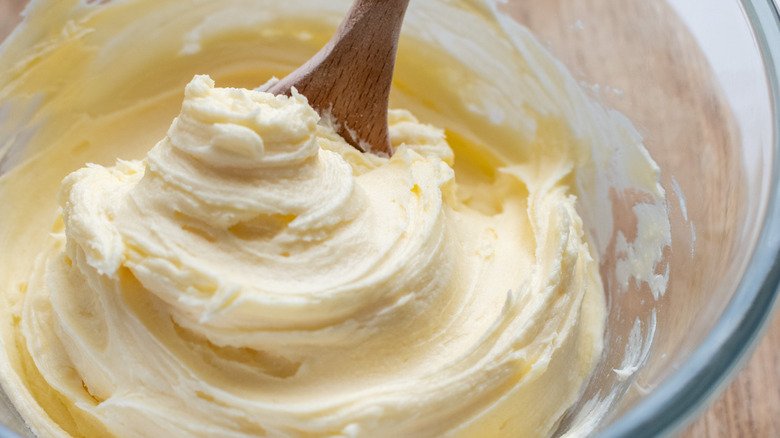15 Mistakes You Need To Avoid When Making Buttercream
No cake, cupcake, or even cookie is complete without a nice thick layer of American buttercream frosting, and truly nothing compares to the homemade kind. Sure, you could easily buy a can of frosting at the grocery store, but the texture and flavor is no match for the kind that you whip up with fresh butter, powdered sugar, and cream. Since it requires so few ingredients, buttercream frosting calls for care and attention when it comes to the quality of your ingredients and the steps you take to combine them.
The tricky thing about buttercream is that it's simultaneously very easy yet particularly difficult to get right. Nearly any American buttercream recipe you stumble upon will call for five ingredients — butter, powdered sugar, salt, vanilla extract, and heavy whipping cream — and will only require about 10 minutes of your time. It seems simple enough, yet all too often the aspiring baker is left with a curdled mess or a frosting that is devoid of any fluffiness.
As someone who has made hundreds of batches of buttercream frosting, I can attest to the steps you want to get right — and perhaps more importantly, the 15 mistakes you want to avoid. Rich, smooth, creamy buttercream is waiting for you, and once you know what pitfalls to look out for, you'll be on your way to frosting gourmet cakes (or mom's birthday cake) like a pro.
Not using room temperature butter
One of the biggest (and easiest) mistakes to make when making buttercream is using butter straight from the fridge. When you try to beat cold butter in a stand mixer, it doesn't break down to a smooth and creamy consistency but instead will form into hard clumps that won't play well with the powdered sugar.
Luckily, there's an easy way to avoid making a clumpy mess of your butter, and that's by allowing it to sit at room temperature for a couple of hours before making the frosting. Room temperature butter is key to making a perfectly smooth buttercream, and it becomes evident from the moment you begin beating it in the mixer. Room temp butter will become smooth, creamy, and pale in color — this means you're doing it right.
Keep in mind that the temperature issue could go the other way around, and you could use butter that's too warm or melty, which will result in a loose, liquidy frosting. This can happen when you microwave the butter to soften it, so avoid doing that. It's a step you can take in an absolute pinch, but ideally, you want to let the butter sit on the counter for a few hours until it's soft enough to press into ─ that's when it's ready to go.
Using the wrong kind of butter
Not all butter is created equal, and this becomes especially apparent when it's the star ingredient in a recipe, which is exactly the case with buttercream. Anyone who has tasted buttercream frosting before can attest to its rich, buttery flavor profile, so if there's ever a time to splurge on the expensive stuff, it's when you're making buttercream. Now, as for what butter tastes the best, that's ultimately up to personal preference, so you might want to experiment with a few types to find the one that works best for you. European butters tend to have a higher butterfat percentage, which lends itself to a richer, creamier flavor, so when in doubt, you can seek out a European-style butter for a safe bet.
While the exact brand of butter that you use will come down to preference, you do want to make sure that you're using actual butter and not margarine. Butter is a dairy product that's high in fat whereas margarine contains no dairy and little fat — two factors that don't work well in a buttercream.
Not beating the butter long enough
A key to making perfect buttercream isn't just using the right ingredients, but it relies heavily on how you work with them. For example, once you get the butter beating — whether it be in a stand mixer or with an electric hand mixer — it may seem tempting to start dumping in the sugar as soon as the butter is smooth. It's important to give the butter time to fully break down so that it becomes smooth and clump-free.
Successful batches of buttercream are light and fluffy, and the fluffiness is achieved through adequate beating of the butter. Now, we're not suggesting that you beat the butter for 20 minutes before you introduce sugar; that'd be a waste of time and would introduce too many air bubbles into the frosting. A solid five minutes of beating will get the job done, and that way your butter will be fluffy enough to retain such a consistency, even once you start weighing it down with powdered sugar.
Using the wrong kind of sugar
Sugar is just as important to buttercream as the butter is, but you'll want to refrain from reaching for the bag of granulated sugar. Powdered sugar is crucial to buttercream for a couple of reasons, and the first is texture related. Powdered sugar is, unsurprisingly, very powdery, which helps it break down and meld into the butter without issue. Granulated sugar is grainy, and while it might break down eventually if you mix long enough, there's still the risk that you'll have a grainy buttercream, and nobody wants to take a bite of that.
Another reason why powdered sugar is crucial comes down to ingredients — unlike granulated, sugar isn't the only ingredient in a bag of the powdered stuff. Powdered sugar also contains cornstarch, which is a thickening agent that aids in keeping your buttercream frosting firm. Obviously you don't want a super-firm frosting, but you don't want it to drip off your cake, and the cornstarch helps hold everything in place.
If granulated is the only thing you have on hand, don't sweat it; after all, powdered sugar is just pulverized granulated sugar, with the addition of cornstarch. Keeping a ratio of 1 cup of granulated sugar to 1 tablespoon of cornstarch in mind, simply add both ingredients to a blender or food processor and blitz until you've got powder.
Not sifting the sugar
Once your butter is smooth and creamy, it may be tempting to start scooping powdered sugar right from the bag and piling it into the mixer. While this won't ruin your buttercream, it will increase the chances of it becoming lumpy, which will make things a bit challenging when it comes to actually decorating your cake. Powdered sugar has a tendency to clump together, so the most surefire way to avoid any clumps is to sift it beforehand — a somewhat tedious process, but one that will save you frustration down the line.
If you don't sift the sugar and end up with a lumpy frosting, a quick trip to the food processor can help rid your frosting of any lumps. However, for those who don't want to bust out yet another kitchen appliance, do yourself a favor and give the powdered sugar a quick sift before adding it the butter.
Adding the ingredients all at once
If you've never made buttercream before and you take a look at the (usually short) ingredients list, you may be inclined to throw everything into your stand mixer at once and start mixing. After all, this has to be the quickest and easiest way to get the job done, right? Unfortunately, if you add the butter, sugar, and cream to the mixer all at once, your frosting won't turn out smooth or fluffy. Sure, you'll end up with a frosting of sorts, but once it comes time to try to spread the buttercream across a cake or pipe it onto cupcakes, you'll run into some problems.
The biggest issue with adding all ingredients at once is that your butter won't have time to cream properly. Also, there's a high chance that you'll end up with a super-lumpy frosting, ridden with both chunks of butter and big globs of powdered sugar. Finally, the amount of cream you add is contingent on how loose your buttercream is once you've combined the butter and sugar, so if you add a certain amount right from the get-go, your frosting might turn out runny.
Not adding the right kind of liquid
The simple combination of butter and powdered sugar will yield a frosting — a thick one, but a frosting nonetheless. Of course, nobody wants to work with a buttercream so thick that it won't spread across a cake, so that's where the "cream" part comes into play. There's no liquid that you should strictly avoid at all costs, but there are a few dairy contenders that are guaranteed to give you a richer, creamier frosting.
Heavy whipping cream has a high fat percentage and, as a result, it adds an undeniable richness to anything it touches. Due to its high fat content, heavy cream is the best option for buttercream if you want to go all-out and make it as delicious as possible (and, realistically, why wouldn't you want to do that?). Half and half has a lower fat percentage but will still add a richness to your frosting and thin it out all the same. Dairy milks like whole, 2%, or skim don't have very high fat percentages so they won't add that ultra-creamy depth to your frosting, but in a pinch, they will get the job of thinning the frosting done.
Adding too much liquid
Oftentimes buttercream recipes will give you a range for the amount of heavy cream you'll need, and it's important to start at the low end of said range. For example, when it comes time to adding in the liquid, you don't want to dump an entire ⅓ cup in all at once, even if that's the high end of what the recipe calls for. You'll run the risk of adding too much liquid, which will give you a runny buttercream — something that can ultimately be fixed, but is not fun to work with.
Another risk of adding too much liquid (especially all at once) is that the cool liquid will shock the room temp butter and cause it to curdle. To avoid these issues, start by adding just a tablespoon or a splash of cream to your frosting at a time. Mix, and if it's still too thick, add another tablespoon at a time until you've got a smooth, pliable icing.
Not adding salt
We know how important it is to season savory foods with salt, but what about sweet ones? Indeed, baked goods need to be seasoned too, and that includes your buttercream frosting. Anyone who has tasted buttercream knows that it's incredibly sweet — by design, of course, and we don't want to dilute that sweetness. However, a little bit of salt goes a long way in mellowing it out just a tad, while also adding a subtle complexity that it'd otherwise be missing.
Now, keep in mind that your frosting won't be ruined if you forget the salt; in fact, it will turn out quite delicious either way. But salt is such an easy addition to make, and you don't even have to measure it (or you could just measure with your heart). Sprinkle or grind a little bit of salt into your next batch of buttercream and we bet you'll notice the subtle difference.
Skipping the vanilla
Very few sweet treats are complete without the addition of vanilla, and much like salt, a little bit of vanilla really helps enhance the flavor of said treat — in this case, buttercream. Without vanilla extract, your frosting's most distinct flavor profile is "sweet" or perhaps "creamy," which aren't bad profiles, but vanilla helps veer your frosting into a more specific flavor direction. Plus, it's one of those things that nearly everyone has in their pantry or cupboard anyway, so a little spritz will liven things up with ease.
As for what type of vanilla you use, that part is up to you. Keep things simple with pure vanilla extract or get fancy with vanilla beans or paste. Whichever vanilla you use, start by adding a small amount, mix it in, and give your frosting a taste. Depending on your preference (or depending on whether you're going to add more flavors down the line), up the ante or call it done.
Not experimenting with flavors
The beauty of buttercream is that it's a neutral base just begging for touches of creativity. Sure, a simple vanilla buttercream is timeless and works well as the base of nearly any cake, but there's a world of flavor opportunity to explore.
One of the easiest ways to add flavor to buttercream without risking the texture is by adding various extracts. Almond, rum, mint, or even maple extract will all bring unique flavors to the frosting, and you'll only need a small amount to make it happen. Powders also work well in buttercream so long as you mix them in well enough — think espresso powder, cocoa powder, or even strawberry Nesquik if you want to think outside of the box.
You can also add in a secret ingredient to enhance your frosting: white vinegar. No, your frosting won't taste like vinegar, but will actually taste a little less sweet, which for some folks is all the flavor manipulation they need to enjoy a slice of cake.
Not scraping down the sides of the bowl
Anyone who has mixed anything in a stand mixer before knows that the contents of the bowl have a tendency to push up against the sides. That very scenario applies to buttercream, so one minute your butter is beating to creamy perfection, and the next you look over and it's spread along the sides of the bowl, not even touching the beater anymore. Luckily, there's an easy fix, and that's to simply stop the mixer every now and then and scrape down the sides of the bowl.
When making frosting, you'll need to scrape down the sides throughout every step. Once the butter has been beating for a minute or two, turn your mixer off and use a rubber spatula to scrape down the sides. Keep repeating this process even after you've added the sugar, cream, and whatever other additions. If you don't, your frosting won't live up to its fluffy potential, plus you run the risk of not evenly incorporating everything — so when it comes time to decorate your cake, the frosting will be streaky.
Using a whisk instead of paddle attachment
Most standard Kitchenaid mixers come with three attachments — a whisk, a paddle, and a dough hook. Obviously, you're not going to need the dough hook to make buttercream, but what about the other two? Both seem like viable options for whipping up a frosting, and realistically, both will get the job done. The paddle attachment is the best option, however, as it adequately beats the ingredients without letting too much air in. The whisk, on the other hand, also beats the ingredients perfectly fine, but it also allows lots of air into the mix, resulting in a bubble-ridden buttercream.
The good news is that a buttercream full of air bubbles is one that can easily be fixed. Also, there's a chance your buttercream will be a little bubbly no matter what you do, so if a whisk is all you have, go ahead and use it. If you do happen to have a paddle attachment, it's your best bet — plus it's easier to clean!
Not mixing by hand at the end
Since you need some high-speed power to beat butter enough to yield buttercream frosting, an appliance — whether it be a stand mixer or electric hand mixer — is crucial to making perfect frosting. That said, you shouldn't start piling your finished frosting onto a cake the second you turn the mixer off, and should instead grab a rubber spatula and mix it by hand for a minute or two.
Mixing a finished frosting by hand serves the humble purpose of removing excess air bubbles, some of which inevitably popped up in your frosting during the initial electric mixing period. This isn't an absolutely necessary step, but by gently mixing the frosting by hand and pushing out any air bubbles, you're giving yourself a much better chance of having a smooth decorating process. Plus, mixing by hand helps you get a feel for the pliability of the frosting, so you can add more sugar or liquid as needed before you start frosting.
Giving up on a broken batch
Sometimes, even after the most valiant of efforts, buttercream frosting just won't come together the way you want it to. Perhaps the butter was a touch too cold and the frosting curdled, or you added too much liquid and you've got a runny mess. It's tempting to throw in the towel, but we can assure you that there are plenty of ways to fix a broken frosting and not put all of those ingredients to waste.
You'll know that your buttercream is curdled because it will look chunky and not entirely appetizing; if this is the case, you need to introduce a little heat to soften up that butter. You can do so by placing your bowl over a double-boiler for a couple of minutes. Then, return the frosting to the mixer and give it a spin — it should come together easily at this point with no curdling, though you may have to add a little more sugar to thicken it back up. You can also add a few drops of boiling water to your buttercream, but be sure not to add too much at once or the frosting will melt.
Another common frosting faux pas is excess liquid, and the easiest fix is to add more powdered sugar. Add a little at a time, just until you reach the right consistency — after all, you want your buttercream to be sweet, but not so sweet that it's inedible.
